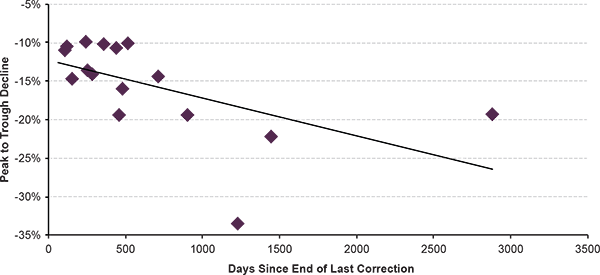The Fed’s not taking the punch bowl from the party, but investors should be wary of the hangover.
by Scott Minerd, CIO , Guggenheim Partners LLC
On a fall night in 1955, Federal Reserve Chairman William McChesney Martin stood before a group of New York investment bankers at the Waldorf Astoria Hotel and delivered what is now considered his famous “punch bowl” speech. It earned this label because Martin closed his eloquent talk by paraphrasing a writer who described the role of the Fed as being “in the position of the chaperone who has ordered the punch bowl removed just when the party was really warming up.”
Current Fed Chair Janet Yellen’s recent congressional testimony suggested that she does not subscribe to her predecessor's temperance. While citing that valuations in certain sectors, such as high-yield or technology stocks, appeared “substantially stretched,” Dr. Yellen's overall sentiment was clear: the Fed does not view the party as having warmed up to the point that the punch bowl need be removed.
The excessive risk taking among investors lulled into complacency by an overly loose Fed is a powerful cocktail indeed -- one that could produce a hangover in the form of volatility. Having said that, the Fed’s party can still go on for a long time. As I’ve said before, bull markets don’t die of old age; they die of an exogenous event or a policy mistake.
In his famous speech, Martin preceded his punch bowl comment by saying, on behalf of the Fed, “…precautionary action to prevent inflationary excesses is bound to have some onerous effects…” The flipside -- a lack of precautionary action by the Fed -- will have its own set of consequences in time. It is very difficult to say when exactly these will happen, but near-term indicators suggest the hangover won’t hit while you’re relaxing at the beach this summer.
Chart of the Week
Equity Markets: The Bigger they Come the Harder they Fall
The S&P500 has now gone nearly 800 days since a correction of more than 10 percent – the “meaningful” level for many analysts. The more extended the market becomes, the larger the eventual decline may be. Over the last 50 years, the longer the time between market corrections, the steeper the drop once the correction does occur.

Source: Bloomberg, Guggenheim Investments. Data as of 7/23/2014. Note: Correction refers to a greater than 10 percent decline from peak to trough.
Economic Data Releases
Mixed U.S. Housing Data with Most Other Data Positive
- U.S. housing starts fell for a second consecutive month in June, unexpectedly decreasing to an annualized rate of 893,000 starts. Regionally, the entire decrease came from the South.
- Building permits slowed to 963,000 in June, with the drop due to falling multi-family permits.
- Existing home sales were stronger than expected in June, climbing above five million for the first time since October 2013. Sales have risen for the past three months.
- New home sales fell more than expected in June, down to 406,000 from a sharply revised 442,000 in May.
- The FHFA House Price Index showed prices rose for a sixth straight month in May, rising 0.4 percent.
- University of Michigan consumer confidence continued to trend sideways in July, falling slightly from 82.5 to 81.3. Confidence in current conditions rose while expectations fell to a four-month low.
- The Conference Board’s leading indicators index rose for a fifth straight month in June, up 0.3 percent. The financial indicators continued to be the main contributors to the gain.
- The Philadelphia Fed Index rose to its highest level since March 2011 in July, up to 23.9 due to a surge in new orders and shipments.
- Initial jobless claims dropped to 284,000 for the week ended July 19, the lowest level in the current expansion.
- The CPI was flat in June on a year-over-year basis, remaining at 2.1 percent. Prices were up 0.3 percent from May, led by gasoline costs. The core CPI inched down to 1.9 percent.
Euro Zone Activity Strengthens but Confidence Falls
- The euro zone manufacturing PMI ticked up from 51.8 to 51.9 in July, with the services PMI reaching the highest level since May 2011.
- Euro zone consumer confidence dropped for a second consecutive month in July, decreasing from -7.5 to -8.4. Confidence has not fallen in two straight months since 2012.
- The euro zone CPI remained at 0.5 percent year over year in the final June reading. Prices, excluding food and energy, inched up to 0.8 percent.
- The manufacturing PMI in Germany was stronger than expected in the July, reading at 52.9. The services PMI reached a three-year high.
- France’s manufacturing PMI fell for a fourth straight month in July, down to 47.6. The services PMI returned to expansionary territory after contracting for two months.
- Retail sales in the United Kingdom were weak in June, falling 0.1 percent excluding auto sales.
- China’s HSBC manufacturing PMI showed the fastest pace of expansion since January 2013 in July, rising to 52.0.
- Japanese exports rose 5.9 percent from May to June after falling for two months. On a year-over-year basis, exports remained in negative territory.
Copyright © Guggenheim Partners LLC













